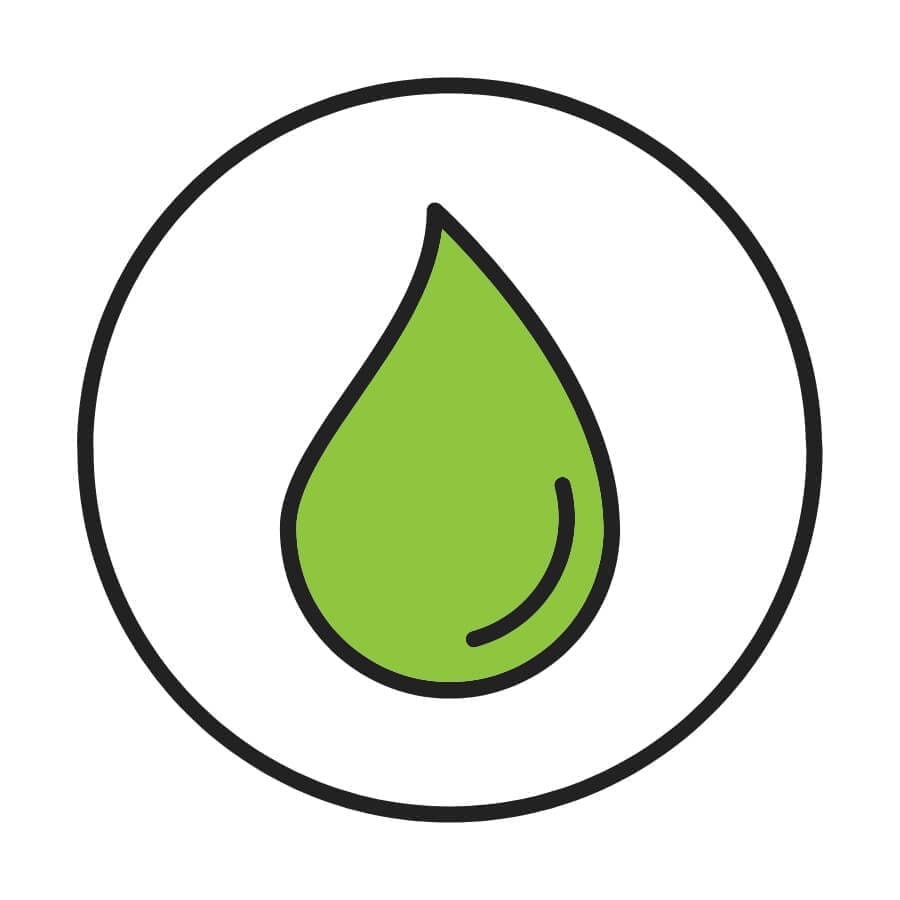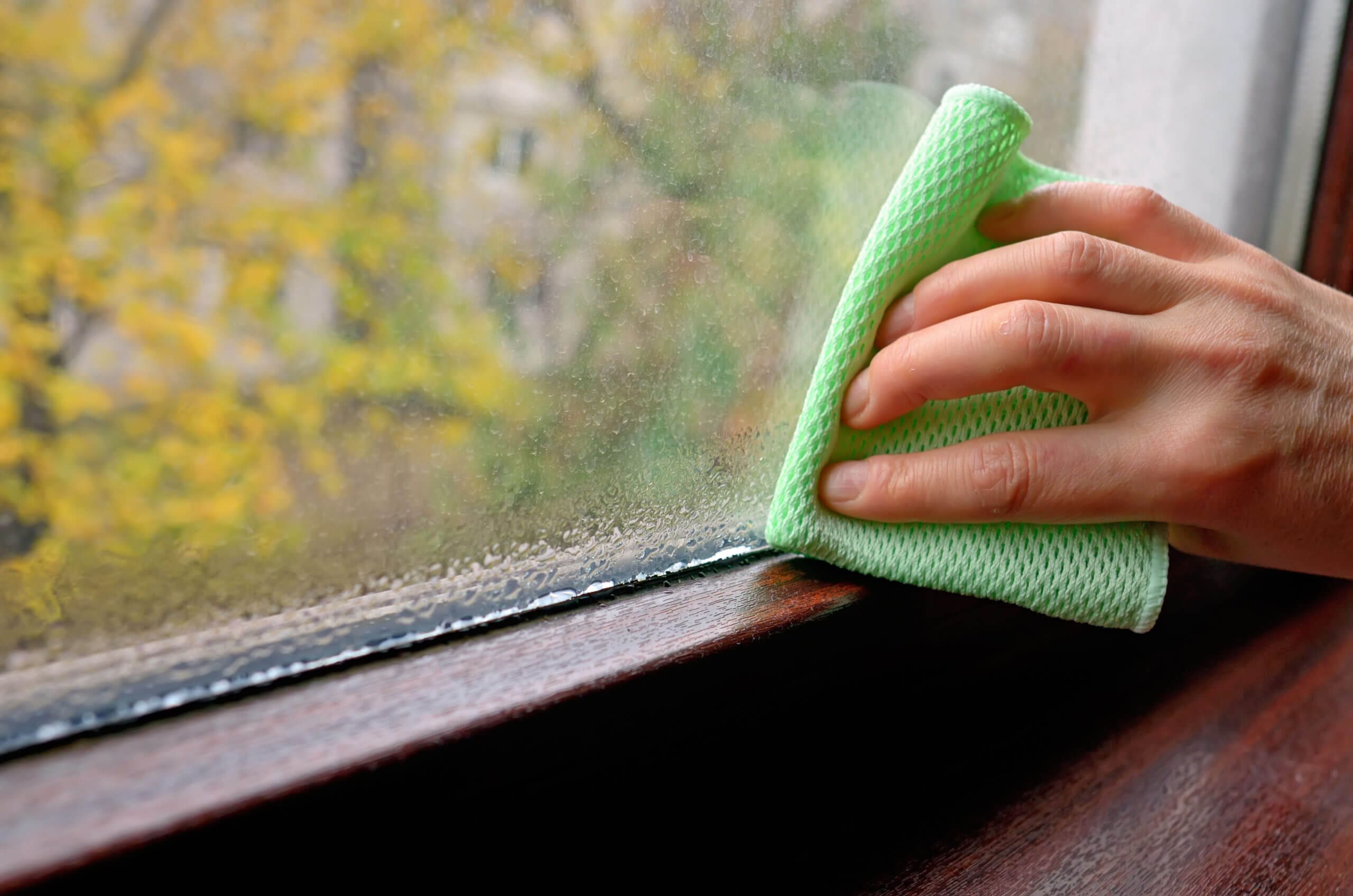The ideal humidity range for homes and indoor spaces is 40 to 60% for a comfortable and healthy living environment. For spaces suffering from higher indoor humidity levels, spending time indoors may not just be uncomfortable, but also unhealthy. Air pollutants thrive with high home humidity levels.
But how do you know when there is too much humidity? After all, good humidity regulation requires humidity. We’ll break down some important signs to watch out for and what you can do to remove extra moisture from your indoor space.
Structural signs of high humidity indoors
Condensation on Windows and Doors
The only time you should notice condensation indoors is when you’re enjoying a cold drink.
Water beads that form on the outside of glasses are normal. This type of condensation is why most of us choose to place coasters under our drinks, in an effort to maintain furniture.
What’s not normal, however, is condensation build-up on the inside of windows and doors.
Condensation on the exterior side is a form of dew and is common depending on the weather and time of day. However, when the build-up is on the interior side, this is the most noticeable sign that your home is suffering from excess humidity.
It’s important to recognize interior condensation because it can serve as a warning sign that there is likely further damage already occurring.
 Commercial Grade Restoration Equipment: Keeping your basement and crawlspace dry should be a top priority for any homeowner. Unfortunately, dealing with dampness and moisture can be a headache if you don’t have the right tools. That is why we highly recommend AlorAir.
Commercial Grade Restoration Equipment: Keeping your basement and crawlspace dry should be a top priority for any homeowner. Unfortunately, dealing with dampness and moisture can be a headache if you don’t have the right tools. That is why we highly recommend AlorAir.
Learn more here →
Structural Damage
High home humidity levels will slowly cause structural damage. Excess humidity will destroy the structure of your home and the items in it. How you notice these changes will depend on the materials in your home.
- Stucco will crumble and slowly tear apart
- Wood floors and wood furniture will warp
- Paint can chip, crumble, bubble, or peel
- Walls and ceilings can stain (discoloration is usually a yellow or rust hue)
The most common signs of structural damage due to high humidity include chipping paint or wood rot on window frames, wet walls resulting from condensation build-up, cracking floors, and plaster walls due to expansion and contraction caused by fluctuating temperatures between day and night as well as summer and winter months.
If you suspect you are experiencing structural damage in your home due to humidity levels it is advised that you contact a local IAQ professional for further inspection.
Health symptoms of high humidity in the home
High humidity levels in the home can have serious consequences for your health.
Not only can it cause discomfort, but it can also lead to an increased risk of respiratory illnesses and other ailments. Some of the most common health symptoms of high humidity are:
Respiratory Problems
Humidity combined with warm temperatures is the perfect breeding ground for mold and mildew, which can cause a variety of respiratory issues including asthma attacks, difficulty breathing, and allergic reactions.
- Allergies
- Chronic Cough
- Difficulty Breathing
- Mild to Severe Headaches
If you find yourself sneezing or coughing more than usual while at home, it could be a sign that your home’s humidity is too high.
High humidity gives life to bacteria, viruses, and allergens in the air. It activates them, increasing the chances you and your family are adversely affected.
If the humidity is too high, you may also feel a tightness in your chest. And if you’re exposed to high indoor humidity levels for too long, you could also develop asthma-like symptoms.
Skin Irritations
Many of us may not typically associate high indoor air humidity with harm to our skin, but the truth is that this factor can wreak havoc for those with sensitive skin.
High levels of moisture can host the growth of bacteria and fungi that can cause skin irritations such as redness, itchiness, soreness and rashes, or eczema flare-ups.
Unfortunately, it doesn’t take much for these conditions to appear; even regular indoor activities like showers or cooking can introduce enough moisture into the air to encourage the growth of bacteria and fungi on our skin.
While those with existing conditions may feel the effects more acutely, everyone should take steps to reduce indoor humidity in order to protect their skin health.
It’s important to understand the consequences of high humidity levels indoors and when needed, regulate them appropriately.
Fatigue & Poor Sleep Quality
High humidity levels can create sleeping problems and poor sleep quality—which in turn impacts your energy levels throughout the day. This is because warm and wet indoor conditions impact your ability to sleep comfortably.
When there’s too much moisture in the air, you may find yourself feeling lethargic and fatigued due to poor sleep quality caused by excessive perspiration or heat rashes from lying under blankets or sheets that are damp from sweat.
High humidity levels in the home can have serious consequences for our health if not properly managed.
Symptoms such as respiratory issues, skin irritations, fatigue, and poor sleep quality should be taken seriously as they could be indicative of excessive moisture in the air. T
to ensure optimal comfort and wellness at home, make sure to invest in the proper tools such as humidifiers and dehumidifiers to maintain healthy humidity levels all year round!
Signs of Mold
One of the most problematic consequences of too much indoor humidity is mold.
Most commonly, mold forms in bathrooms or basements where moisture is stagnant and remains in a space for longer periods of time without proper ventilation.
Mold is a particularly problematic air pollutant because it spreads easily through microscopic mold spores.
Does your house smell musty or perhaps just noticeably off? This could be from mold growth as well. If you notice an odor but can’t find any visible mold growth, you should still call a professional because it can continue to grow before its observable.
The Solution? Whole-Home Dehumidifiers
The best way to regulate indoor humidity levels in your home is to upgrade to a whole-home humidity control system.
 Whole-Home Humidifiers We Recommend: We know how important it is to make sure you’re choosing the best product for your needs. That’s why we have a dedicated information page on whole-home humidifiers, with specific details about each available type! We always recommend consulting with a local IAQ expert before any final decision or major purchase. Learn more here →
Whole-Home Humidifiers We Recommend: We know how important it is to make sure you’re choosing the best product for your needs. That’s why we have a dedicated information page on whole-home humidifiers, with specific details about each available type! We always recommend consulting with a local IAQ expert before any final decision or major purchase. Learn more here →
To remove excess humidity and better balance your space’s indoor relative humidity, we suggest whole-home dehumidifiers. A dehumidifier quite literally uses an internal fan to capture air and remove moisture from air particles to ensure only drier air remains in circulation.
These systems are highly efficient and can remove between 70-155 pints of water each day from your indoor air (depending on the model). Choosing the ideal dehumidifier depends on the size of your home, business or indoor space.
While choosing to upgrade your HVAC system may feel like a big step, it’s important to remember the many ways poor humidity control impacts the health of those in your home and the quality of your indoor space.
Choosing to ensure ideal humidity levels is the better and more cost-efficient step in the long run.



